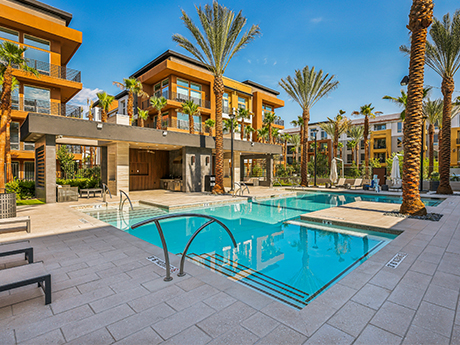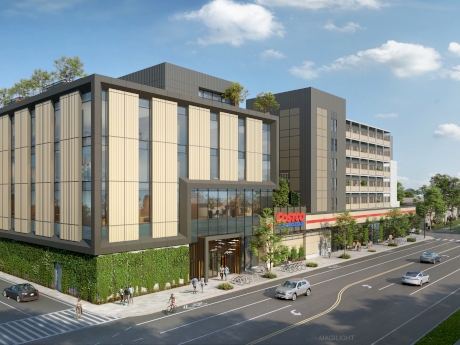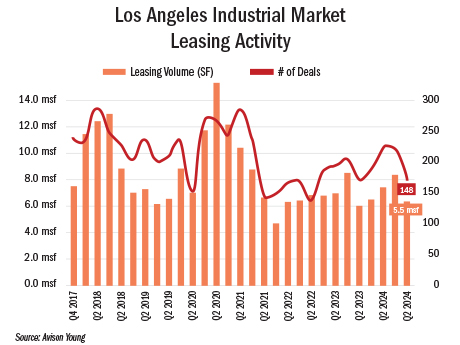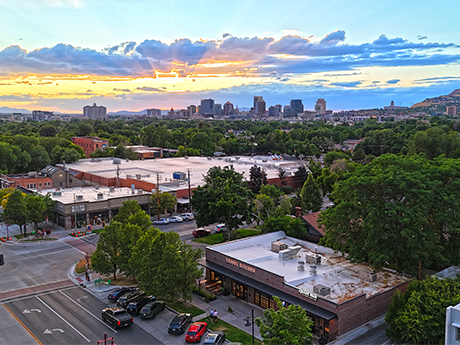— By Liz Claire of Avison Young — The Las Vegas retail market continued its strong performance in fourth-quarter 2024. Vacancy rates declined to 5.3 percent, marking a 200-basis-point drop from the fourth quarter of 2020. Strong absorption rates and healthy rent increases highlight the market’s resilience, even as growth has moderated since its peak in first-quarter 2021. Vacancy Declines and Strong Absorption Las Vegas experienced a significant increase in positive retail space absorption in fourth-quarter 2024, following eight quarters of minimal movement, with a total of 619,000 square feet absorbed. This surge was primarily driven by major developments, including the completion of the 500,000-square-foot BLVD retail project, which saw strong pre-leasing activity from prominent tenants like Adidas, H&M, Lululemon and In-N-Out Burger. Sustained high demand lowered the vacancy rate by 40 basis points from the previous quarter, further solidifying Las Vegas as a leading retail market. Retail Rents and Growth Trends Market-wide retail asking rents averaged $35.20 per square foot, with rents outside the high-priced resort corridor averaging $29.08 per square foot. Year over year, rents increased by 5.8 percent, significantly outpacing the national average rent growth of 3 percent. This steady rent appreciation demonstrates continued demand for retail space in …
Western Market Reports
— By Charles Van Geel of Cushman & Wakefield — Despite broader economic headwinds, Southern Nevada’s commercial real estate market continues to showcase remarkable resilience – especially in the office sector. The demand for high-quality office space remains strong in the Southwest and Summerlin submarkets, underpinned by a flight to quality and shifting corporate priorities toward top-tier environments. The bulk of today’s office activity is concentrated along the critical Interstate 215 corridor, stretching from Green Valley to Summerlin parkways. This corridor has become the heartbeat of the region’s office market. However, within this high-demand stretch, the availability of true Class A product (particularly in the Southwest submarket) is diminishing. Small blocks of space are becoming increasingly rare, while sublease opportunities along this corridor are practically nonexistent. Adding pressure to this is the fact that new construction is largely stalled. Speculative development is not economically feasible with the current market dynamics. Lenders are unwilling to fund projects unless developers can demonstrate significant preleasing commitments, often north of 50 percent. This has been a challenge, as preleasing activity in the broader market remains minimal. Still, the area has received a few recent high-profile deliveries. These include Downtown Summerlin’s 1700 Pavilion, Phase II of …
— By Jerry Doty of Colliers — While several other Western markets started to slow down in late 2022 or early 2023, the Southern Nevada industrial market seemed to be relatively unscathed going into 2024. However, the impact was finally felt early in the first quarter of 2024. It lasted through the remainder of the year. Despite this noticeable decline in activity, most remained optimistic that it would be a quick slump. We were hoping 2025 would come out with guns blazing. These prognostications have so far proven to be incorrect. First-quarter 2025 felt very much like the past four quarters. This noticeable slowdown could not have come at a worse time. We are in the midst of a record wave of new completions that will continue to deliver through the third quarter. The Las Vegas industrial market delivered a little less than 16 million square feet of new inventory in 2024, bringing the total market up to 180 million square feet. The Valley is composed of eight different industrial submarkets, with the North being both the largest in total size (75 million square feet) and the largest amount of product under construction (almost 3.6 million square feet). At the …
— By Adam Schmitt of CBRE — The Las Vegas multifamily market is experiencing a significant transformation that’s shaped by new construction trends and evolving market dynamics. As the city continues to expand and adapt, it is essential for current investors, developers and capital allocators to understand the opportunities and barriers for growth. The multifamily market has seen substantial fluctuations since the onset of COVID-19. Rents surged by 24.6 percent in 2021, buoyed by government interventions. However, as these supports diminished, vacancy rates rose sharply, climbing from an average of 3.4 percent in 2021 to 7.35 percent in 2023. Recent trends, however, indicate a recovery. Vacancy rates have decreased to 6.5 percent as of February, which hint that multifamily fundamentals may be regaining stability and moving toward normalized averages. The single-family housing market is another critical element influencing the overall health of Las Vegas’ economy. The market produced 160,092 single-family homes between 2003 and 2008. However, only 142,455 were built between 2009 and 2024. This slowdown has led to soaring home prices, even amid rising mortgage rates approaching 7 percent. Consequently, the growing disparity between renting and owning has created favorable conditions for rental housing demand, further solidifying the multifamily …
— By Kalli Knight of Colliers — The Los Angeles multifamily market faces several headwinds, including rising expenses, the aftermath of recent fires, insurance exclusions and Measure ULA. These factors impact transaction volumes, leading many investors to remain on the sidelines. However, Southern California and Los Angeles will continue to have strong fundamentals, attracting a unique pool of buyers. This includes qualified, high-net-worth family offices eager to take advantage of limited competition to acquire new construction at prices below replacement costs or favorable debt terms. Management companies are increasingly critical in supporting property stabilization post-pandemic, with a growing urgency to enhance operations and increase net operating income. As construction loans mature, their impact on property stabilization is significant. Though the concession rate of 0.7 percent is significantly less than the national concession rate of 1.1 percent, many developers now offer four to six weeks of concessions to lease properties and meet projected rents outlined in their financial analyses. Some developers have also opted for creative strategies, such as providing customized closets to attract renters at higher luxury price points instead of relying solely on weekly concessions. Vacancy rates in the market vary, but have generally improved since 2024. They have …
— By Tony Solomon of Marcus & Millichap — The positive relationship between retailers and rooftops is proving true in key ways across Los Angeles County. The market’s retail vacancy has risen in recent years — with the metro-wide rate up 120 basis points since 2022 – but the overall measure of 6.5 percent belies strong local dynamics. Retailers are continuing to find opportunities, especially in zones with recent and upcoming residential growth. Multifamily vacancy dropped by 50 basis points or more last year in the Santa Clarita Valley, Southeast Los Angeles and the South San Gabriel Valley. These same submarkets recorded retail vacancy rates at or under 5.2 percent at the onset of this year, which are some of the lowest in the county. Property performance momentum is set to continue in those areas amid numerous upcoming move-ins, including from tenants like Savers and Planet Fitness. The growing local apartment sector is expected to help absorb the primary area of heightened availability: Downtown Los Angeles. Retail vacancy here jumped 220 basis points last year to 9.1 percent, more than 100 basis points above the next highest submarket. Thankfully, that vacancy pressure may begin to ease in the near future. …
— By Caleb Hodge of KWP Real Estate — The Los Angeles office market is undergoing a transformation. Finally. Downtown LA and most of the submarkets were decimated following the pandemic, but leasing activity is increasing. In fact, the fourth quarter of last year saw the highest annual leasing activity since the pandemic was officially declared “over,” according to Savills Research and Data Services. How is this possible? The answer lies in the evolving identity of office spaces, which is driven by the demand for creative office. Despite increased asking rates in certain submarkets, Los Angeles is still a tenant-driven office market. The rub is that hybrid-working models continue to, at times, complicate leasing decisions. Fortunately, highly sought-out creative office space in Los Angeles offers two key incentives: premium amenities and functional, innovative office designs. Creative office space may still be considered niche, but the amenities and design layouts are critical when bringing employees back to the office. In fact, those attributes are highly desired by most modern office workers, whether their industry or physical space is considered “creative” or not. With traffic being a constant factor in LA, centrally located offices with easy commutes for a majority of workers …
— By Patrick Barnes of Avison Young — The Los Angeles industrial property market has experienced increasing space availability and shifting tenant priorities over the past several quarters. Due to concerns about potential labor strikes at East and Gulf Coast ports, the anticipated surge in short-term sublease demand failed to materialize in the fourth quarter of 2024. Additionally, with a labor contract agreement reached in January, any lingering expectations that rerouted shipments would continue to bolster West Coast activity have largely dissipated. Despite a 21.7 percent year-over-year increase in TEU (twenty-foot equivalent unit) volume from 2023 to 2024, sublease availability has risen significantly as TEU tenants have either warehouse capacity or shipments leaving the region by rail. Companies today are reassessing their space needs, focusing on cost savings and operational optimization rather than expansion to deal with inflation and tariffs. Sublease space increased by 12.8 percent quarter over quarter, reaching 11.2 million square feet and pushing the overall availability rate to 9.3 percent. These changes have also led to a drop in industrial rental rates. After peaking at $1.97 per square foot in 2023, average rents have fallen 26.4 percent to $1.45 per square foot in fourth-quarter 2024. However, Class …
— By Brian Anderson of CBRE — Utah’s retail market is shaped by its young population and large households, driving demand for big box stores and quality consumer brands. Utah has the youngest median age of any state in the U.S. by nearly four years, and the largest median household size. Our retail real estate market mirrors these realities. Large-box grocers and membership warehouses dot the landscape, creating gravity points that draw junior boxes, shops and restaurant users to these neighborhoods. Utah’s household incomes continue to rise, while the per capita income remains average. This has led to a concentration of quality — though not luxury — consumer brands in most retail centers. Despite challenges in construction and finance markets, Utah’s ongoing housing expansion is pushing box users and grocers to open new locations. The Salt Lake and Provo MSAs are expected to see several new big box and large grocery stores, mostly in outlying communities, after a quiet 2023 and 2024. Smaller-format grocers focused on organic food are also in permitting stages in established communities. These new locations will spark competition for restaurant and shop users. Health-conscious brands are expected to take space in desirable centers as 2025 progresses. …
— By Rawley Nielsen and Mark Jensen of Northmarq — The Salt Lake City apartment market has undergone significant shifts over the past few years, shaped by broader economic headwinds and local supply dynamics. Fortunately, optimism is returning to the market as interest rates stabilize, supply is absorbed and buyers see new opportunities to enter at attractive pricing. Over the past 36 months, rising interest rates have created challenges for multifamily investment, which have impacted underwriting and transaction velocity. However, recent weeks have provided a reprieve as Treasury rates have come down, bringing renewed energy to the market. Volatility remains a factor, but there is a growing sense that we are at or near the bottom, leading to increased investor interest. One of the biggest headwinds in Salt Lake City has been the supply wave, particularly in the downtown market where an influx of new multifamily deliveries has made it difficult for buyers to underwrite rent growth. Both 2022 and 2023 brought unit deliveries totaling more than 4,000 units, nearly triple the average annual delivery count from the past 10 years. We saw nearly 3,000 units delivered last year, and our team is tracking a similar amount for 2025. …
Newer Posts





